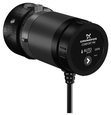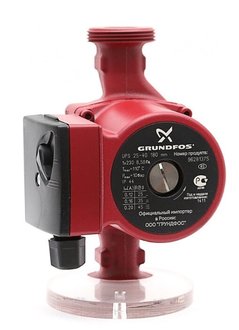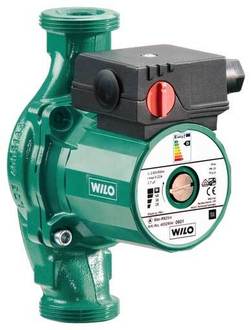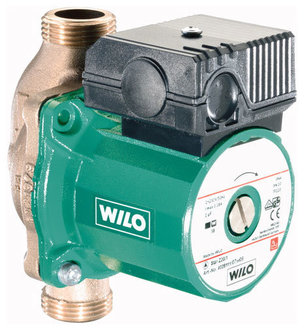Top 10 heating pumps





Normal operation of a heating system without forced circulation is difficult to implement: although natural circulation due to the difference in densities of the heated and cooled coolant is possible, its only plus is maximum simplicity. On the other hand, it is enough to start melting the boiler, as soon as the difference becomes clear: as long as the “natural” system still does not have a tooth to tooth (the natural circulation is so inertial that the boiler can already boil, and the batteries will remain barely warm), the forced circulation will heat the radiators rooms. Forced circulation is far less sensitive to the configuration of the heating system (there will be enough pressure to drive away even an unsuccessfully designed one). Finally, the transition from water to propylene glycol coolant can simply paralyze the previously operated heating system without a pump: viscosity and density of the coolant vary significantly. So shouldn't you just put the pump? If you have a double boiler or a separate boiler, then a separate pump will definitely need to be - how else would you supply hot water to the faucets?
It remains only to choose not only the best in terms of performance and price, but also a quality circulation pump: it is unlikely that you will like to reanimate your heating in February frosts.
Rating of the best circulating pumps for heating systems
| Category | A place | Name | Rating | Price |
|---|---|---|---|---|
| The best circulation pumps for heating systems with medium resistance | 1 | Grundfos UPS 25-40 180 | 9.7 / 10 | 6 216 |
| 2 | Wilo Yonos PICO 25 / 1-6 | 9.6 / 10 | 8 477 | |
| 3 | Grundfos UPS 32-80 | 9.6 / 10 | 19 449 | |
| 4 | DAB VS 65/150 M | 9.5 / 10 | 11 911 | |
| 5 | Wilo Star-RS 25/4 | 9.5 / 10 | 5 350 | |
| 6 | Wilo Star-RS 30 / 6-180 | 9.4 / 10 | 7 258 | |
| 7 | Aquario AC 254-180 | 9.0 / 10 | 3 790 | |
| The best circulation pumps for high-resistance heating systems | 1 | Wilo TOP-S 30/10 EM PN6 / 10 | 9.7 / 10 | 22 624 |
| 2 | BELAMOS BRS 25 / 8G (180 mm) | 9.1 / 10 | 5 185 | |
| The best circulation pumps for hot water | 1 | Grundfos COMFORT 15-14 BA PM | 9.8 / 10 | 14 872 |
| 2 | Wilo Star-Z 20/1 CircoStar | 9.7 / 10 | 9 311 |
The best circulation pumps for heating systems with medium resistance
|
6 216
A forty-five circulating pump is well suited for heating an “average” private house, where there is no need for a high lift and pumping large volumes of liquid. Its capacity is slightly less than three cubic meters per hour, the pump copes equally well with the prepared water and propylene glycol. The engine has three positions of power control and is quite economical, consuming no more than 45 watts. The rotor is completely isolated from the stator, which is necessary for maximum protection from leakage. The shaft and the radial bearings are ceramic, so their resource does not cause the slightest criticism. This is especially important when using ordinary water in the heating system, since, unlike antifreeze, it does not have "oiliness". The sleeve separating the rotor and stator is made of stainless steel, and this is another big plus for durability. In general, pleases attention to the details - for example, to access the terminals in the box does not need a screwdriver, just turn the flag on the lid. The pump is easy to install, workable in any position. However, it is worth noting that with the current globalization, pumps of this line are produced all over the world - from the “native” Denmark to China. And it is believed that the "European" more reliable than those produced in China. We will not comment on this: it is possible that the complaints about the Chinese Grundfos are not addressed to the original production of the plant, but to the imitation that is so beloved by our Asian neighbors - well, or to the "left" rejection of the main production, this does not surprise us for a long time. Main advantages:
Minuses:
|
 9.7 / 10
Rating
Reviews
The pump is good and reliable, especially and I bought it even at the old rate, much cheaper. |
|
8 477
A “smart” digitally controlled pump can lift up to 6 meters, so even if your boiler is installed in the basement, the radiators will not stay cold. It is possible to aim a blow at the heating of a two-story house, but do not forget about the performance: 3.7 m³ / h - this is not so much for large areas. But the electronics here are more than functional and at the same time do not cause the sensation of unnecessary bells and whistles, like in the top Grundfos with color liquid-crystal displays. After turning on the pump, the air purge mode starts automatically (it can also be manually turned on if necessary), then the switch can be used to set the desired mode of operation. Three options are available with three power values: radiator heating, floor heating or the classic constant speed adjustment mode. In the first two cases, you need to select the appropriate icon ("small house", "middle house", "big house"), then using the digital indicator set the desired height. After that, the pump itself calculates the necessary speed. In the constant speed mode, the indicator shows power consumption in watts. Another advantage of this circulation pump is the way to connect the power. He used an external pad with a sealed connector - you connect the power to the counterpart of the connector, and then just snap it onto the pump. If necessary, the pump can be turned off safely and without any tools. Main advantages:
Minuses:
|
 9.6 / 10
Rating
Reviews
I liked the pump: it is convenient to fill the heating system, it is more flexible than the usual ones with a simple speed controller. |
|
19 449
The powerful and reliable pump with the case from bronze. A single-phase electric motor with a wet rotor and a protected stator is capable of pumping 11 cubic meters of water per hour, this is enough even for the longest heating system in a private house. The pump is installed in any position. Consumes in the maximum mode 135 Wh. The impeller is corrosion-resistant, the axial bearing is made of graphite. An expensive pump, but worth the money. Main advantages:
Minuses:
|
 9.6 / 10
Rating
|
|
11 911
Although this Italian pump is both reliable and productive (5.4 m³ / h, maximum pressure 6 m), we cannot give it first place in the ranking of the best circulating pumps for good reason: the price affects. Of course, they didn’t save on materials here - the same case is not made of cast iron, which in general is a classic solution for heating system pumps, but of “tsvetnina”. Inside the pump - a classic combination of ceramics, stainless steel. Insulation of the “wet” part is provided by silicone seals, coping well with their work at temperatures up to 115 degrees. Work on the prepared water or antifreezes is allowed. Please note that the manufacturer allows the use of coolants containing no more than 30% glycol, while Grundfos allows the use of 50 percent antifreeze. The only thing we don’t want is to read the “native” installation instructions, oddly enough: the author has not seen the more consuming eye and confused document. Main advantages:
Minuses:
|
 9.5 / 10
Rating
Reviews
Made in Italy, not in China. Weighty, inspires confidence. Works well, pumps the system right. |
|
5 350
It is applied in systems of heating, water supply and ventilation. It has three rotation speeds.The pig-iron case and shaft from a stainless steel provide rather high reliability of the pump. It is installed only in a horizontal position, is able to pump up to 3 cubic meters. meters of water per hour. Almost insensitive to the temperature of the liquid, but does not like too hard water. It works very quietly. Main advantages:
Minuses:
|
 9.5 / 10
Rating
Reviews
The best circulating pump for heating - set in a bath, costs more than 7 years, you forget that you have systems to maintain - turned on and forgot. |
|
7 258
This circulation pump has a good margin of lift height (5.5 m), so it quietly "pushes" not even the most successful heating system of a two-story house, where the boiler is installed in the basement. Capacity - up to 3.5 m³ / h, so that it will pull a large enough area. Speed adjustment - simple, three-step. Of course, in terms of efficiency, the pump cannot be called ideal: it “eats” up to 84 watts, while modern models that are comparable in terms of parameters can cost half the power. Another thing is that their price is already higher. The pump body here is made of ordinary cast iron, which is immediately felt by weight. This made it possible to reduce the price, but at the same time it lowered the corrosion resistance - in order to prevent excess rust in the system, it is better to use a coolant with corrosion inhibitors. Main advantages:
Minuses:
|
 9.4 / 10
Rating
|
|
3 790
Capacity up to 1.8 m³ / h may seem small, but for a small private house in a two-pipe system, it will even give a certain margin. At the same time, the circulation pump is inexpensive and shows itself in practice satisfactorily - if not at the level of top brands, then, taking into account the difference in price, it is still very, very good. The pump casing is cast iron, which is not surprising at such a price. Maximum power - 48 watts. But its origin is quite interesting: for example, the official Russian-language site points to a certain Italian brand, the products of which seem to have been imported before, and now they have been imported by the Russian assembly. The search for “grandparent” in Italy led us to Comex Srl, which really produces pumps ... but there is no mention of the Aquario brand on their website (and the pumps themselves, to put it mildly, more), as there is no information about the Aquario pumps in Italian segment of the Internet in general. So, it seems, this is still an obvious gesheft of Moscow poets, working “for Europe” for marketing sake. Hmm, somewhere we have already encountered this in our ratings ... Therefore, a little throw off the rating and for this, despite the fact that the circulating pump for heating, in general, not bad. Main advantages:
Minuses:
|
 9.0 / 10
Rating
|
The best circulation pumps for high-resistance heating systems
|
22 624
When creating this line of pumps, it was decided not to be petty: the massive cast-iron TOP-S 30/10 EM PN6 / 10 with flange mounting per hour is able to pump up to 12 cubic meters of coolant, ensuring a maximum lifting height of up to 10 meters: this allows you to confidently work with systems that have high hydraulic resistance. The “middle point” on the graphs (about this below) corresponds to 6 cubic meters with a lifting height of six meters. Motor power corresponding - 410 watts. Speed, as usual, three.Due to the solid layer of anti-corrosion coating, the case is very durable, moreover, it is allowed to work at extremely high temperatures at elevated pressures (up to 140 degrees, but not more than 2 hours). Main advantages:
Minuses:
|
 9.7 / 10
Rating
|
|
The combination of a Russian brand with an unknown origin (either Taiwan or mainland China), which is classic for our realities. However, with a good ratio of price and quality. But look attentively at the pump - reminds nothing? Yes this is Grundfos UPS, even the junction box opening flag is absolutely identical. Hmm, is it not from that Asian factory that the “left” Grundfos pumps lead a biography? However, we will not portray Sherlock Holmes. The pump has a maximum capacity of 5.28 m³ / h, the maximum value of head - 8 meters. With proper heating design with the “number of floors”, the pump will have no problems. By design, it really is a clone of Grundfos, which, with a sufficient level of copying (albeit with cheapening), promises an acceptable resource. Main advantages:
Minuses:
|
 9.1 / 10
Rating
Reviews
It works fine. The noise is moderate. The first speed is enough, so the motor is not guaranteed to be overloaded. |
The best circulation pumps for hot water
|
14 872
A modern solution for ensuring “smart” recycling in the hot water supply line of double-circuit heating boilers. A feature of this pump is a built-in digital control circuit that automatically adjusts the speed to the current mode of operation. It is equipped with a thermal sensor, which is fixed on the pipe: the speed is regulated depending on the temperature, providing a quick warm-up of the water supply circuit. Thus, the system warms up quickly and at the same time ensures minimum power consumption in the “standby mode”. The AutoADAPT function allows you to react to changes in water consumption. By itself, a motor with permanent magnets is extremely economical and has a small starting current, in contrast to conventional pumps with asynchronous "single-phase shifters." Seven watts? Yes, it consumes the pump at maximum power. Therefore, it is absolutely undemanding to backup power supply systems: the simplest bespereboynik will cope. The maximum amount of feed - 8.3 liters of water per minute, this is enough for a small house. The main problem of the pump is quite understandable - it is by no means a budget. Given the cost of electricity, the difference in cost with more affordable models will pay off for a long time. Main advantages:
Minuses:
|
 9.8 / 10
Rating
Reviews
Great pump! I have an autonomous boiler, so that the bespereboynik was put only on the pumps - and with that, my water remains in the taps even after a few hours. |
|
The German company, which has been working since the end of the 19th century and crowned with many laurels (here you will find both the LACP Vision Awards and the European Product Design Award, and even the “Best Employer of Germany”) offers us a circulation pump of a corresponding volume of quality, but, alas, corresponding price. Star-Z 20/1 CircoStar is designed specifically for work in “water” circuits, providing up to 31.6 liters of water per minute. The design of the pump is a classic one, with an asynchronous motor of constant rotational speed and an adjustment of the speed of rotation.The shaft is completely ceramic, which is perfect for drinking water, the case is bronze, and the impeller is made of polymer. So the lack of "bells and whistles" allows us to think that we are paying for the quality. The power consumption of the pump is small: 38 W at maximum power. Neither in silence nor in reliability did we have any complaints about it - the pump is really one of those that can be connected and forgotten. Main advantages:
Minuses:
|
 9.7 / 10
Rating
Reviews
As set, so it works. I have enough of the second position of the power regulator, the pump is not audible at all. |
How to choose a good pump for heating?
First of all, of course, the circulation pump must comply with the boiler specificationswhich, in turn, are selected proceeding from their heated area. Otherwise, if there is insufficient flow, the “extreme” batteries will be too cold.
An approximate formula for calculating the desired performance is simple: Q = 0.86 x P / dt. Here P is the thermal power of the system, and dt is the delta of temperatures at the outlet of the boiler and in the return line. That is, if we use a 40 kilowatt boiler and we want to provide a delta of 20 degrees (usually this value is taken for normal operation), then we would in theory have a productivity of 1.72 cubic meters per minute. Then why did we bring in the rating much more efficient pumps? Wait, that's not all.
During operation, the circulation pump must overcome the hydraulic resistance of the heating system. Please note that it is precisely this that is important, and not the height of the system: the return balance balances the flow, that is, if the resistance is equal to zero, the pump would not actually be loaded by pumping. But in reality, the resistance of pipes and radiators will always be there. A rough calculation for a two-pipe system gives the required lifting height equal to the number of floors multiplied by a factor from 0.7 to 1.1, for a collector-beam it increases to 1.16-1.85. That is, if we heat the “two-pipe” two floors and the boiler is in the basement, then the lift height from the pump is about 3.3 m. Again, less than the pumps in the rating.
The fact is that the height of volume and performance for the pump are antagonists: increasing resistance inevitably limits performance. Therefore, each pump in the documentation is a graph of the height-performance for each speed. So, the pump that is suitable for us should have such a schedule so that the points of the required productivity and the height of the lift would intersect it approximately in the middle - such a “middle point” guarantees us that the pump will not be overloaded. This is especially important at the time of start-up, because the motor has to unwind immediately under load. Accordingly, the limiting figures of performance and lift height for a properly selected pump will be higher than those obtained from the calculation.
Also note that the glycol coolants have a viscosity increased in comparison with water, and the graphs are for water: you need to make a reserve for this too. In this case, the manufacturer must directly indicate in the characteristics of the pump the maximum concentration of propylene glycol in the coolant.
Finally, the pump itself must fit the installation method (not everyone can work both horizontally and vertically) installation dimensions. Otherwise, the already collected heating will have to be redone.
Have a good shopping!






